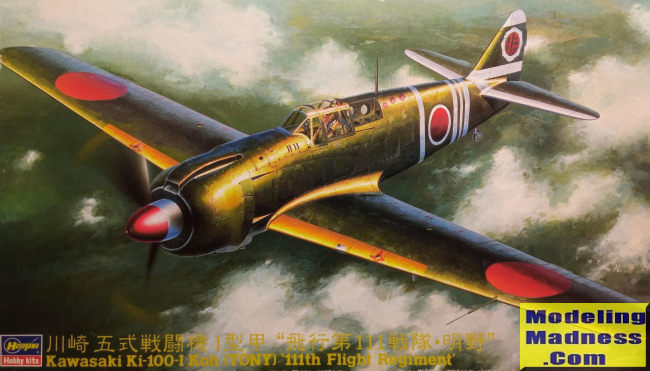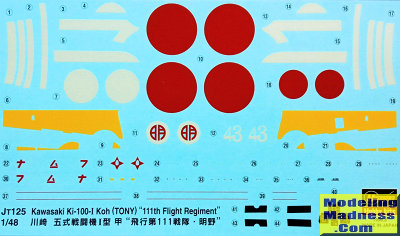
Hasegawa 1/48 Ki-100-Ikoh '111th Flight Regiment'
| KIT #: | 09185 |
| PRICE: | €15 “special offer” in 2005 |
| DECALS: | One option |
| REVIEWER: | Spiros Pendedekas |
| NOTES: |

| HISTORY |
The Kawasaki Ki-100 was a single-seat
single-engine monoplane fighter flown by the Imperial Japanese Army Air Service
during World War II. Designated as "Type 5 Fighter" (五式戦闘機,
Go-shiki Sen-touki, or abbreviated as Goshikisen), it emerged as an emergency
measure, when 275 Ki-61s were modified to accept the 14-cylinder Mitsubishi
Ha-112-II radial engine in place of the original Kawasaki Ha-40 inverted V-12
inline engine, which faced shortage and reliability problems.
This modification resulted in one of the best WWII interceptors, combining
excellent power and maneuverability, with the type’s superiority becoming
evident from the first operational missions in March 1945, performing better
than most IJAAF fighters against Superfortresses, Mustangs and Hellcats.
An improved variant with a cut down rear fuselage, designated as Ki-100-Ib, was
produced during the last months of the war and equipped five home defense
Sentais. High-altitude performance was further improved with the final variant,
the Ki-100-II, however only three of these were produced before the war ended.
| THE KIT |
 The
first attempt to reproduce a quarter scale Ki-100 came from as far back as 1974,
when Otaki presented a very nice (for the time) “bubble canopy” version of the
iconic fighter, later reboxed by Arii.
The
first attempt to reproduce a quarter scale Ki-100 came from as far back as 1974,
when Otaki presented a very nice (for the time) “bubble canopy” version of the
iconic fighter, later reboxed by Arii.
Fast forward to 1995, when Hasegawa decided to treat us with a state of the art
(back then), also “bubble canopy” Ki-100, with the “fastback” version following
a year later and both versions regularly reboxed ever since, the last one being
in 2015. The subject kit is one of the two initial release “fastback” versions,
bought in 2005 from a (sadly now closed) hobby shop in Athens at a very low
price.
It comes in the typical Hasegawa top opening box of excellent quality, featuring
a most attractive box art of the kit subject plane, which is 111th Sentai’s #43.
Though not carrying his signature, it is pretty obvious that the box art is
painted by Koike Shigeo.
Upon opening the box, I was greeted with 74 light gray styrene parts, arranged
in seven spues of various sizes, with some of them being common with the
company’s Ki-61. Not all the parts are used, with the unused ones being correct
for other versions. As usual, all sprues are bagged together, meaning some
potential scratches.
Molding is excellent with no flash noted. Some mild ejector pin marks which will
be visible upon finishing were noted at the usual suspect places (like doors
innards), not looking too difficult to take care of, though. Panel lines are
recessed all over and superbly done.
The cockpit features all basic elements, including nicely detailed sidewalls
with some extra levers. While not too crowded (having a look at net pics
revealed a certain degree of busyness in the Ki-100 cockpit, with a multitude of
levers and other “bits” scattered all around), the kit provided cockpit is well
rendered and will be sufficient for most of us.
Moving to the engine, the two cylinder rows, while molded together, look quite
convincing, as does the crankcase, the very nice mini exhausts and the one piece
prop. Landing gear is sufficiently represented, with bay innards looking unbusy,
something that was also observed in reality, so all good there! Two nice wing
tanks are also provided.
Clear parts are superbly molded and crystal clear. The landing light lens and
gunsight are the Hien’s ones, with Hasegawa providing the complete Hien clear
sprue, meaning you will be left with a very nice Hien spare canopy! Instructions
come in the usual superb Hasegawa pamphlet form, containing a short history of
the type, a sprue diagram, with the uncomplicated construction finely spread in
12 simple and concise steps, including color callouts where applicable.
 Only one
scheme is provided, of #43 bird belonging to 111 Sentai, as it stood in Akeno
airfield in July 1945. The decal sheet is sharply printed and of supreme
quality, with the white areas being “old school Hasegawa”, meaning represented
as “ivory”. The sheet includes the yellow ID sections and a plethora of
stencils and, despite being almost 30 years old, looks brand new.
Only one
scheme is provided, of #43 bird belonging to 111 Sentai, as it stood in Akeno
airfield in July 1945. The decal sheet is sharply printed and of supreme
quality, with the white areas being “old school Hasegawa”, meaning represented
as “ivory”. The sheet includes the yellow ID sections and a plethora of
stencils and, despite being almost 30 years old, looks brand new.
Instructions want you to first assemble the cockpit and sidewalls, then trap
them, together with the exhausts and engine, between the fuselage halves, with
wings, tail planes and cowling lip coming next. The famous poly cap that will
hold the prop shaft firmly will have to be trapped in before attaching the
crankcase to the cylinders.
Landing gear and external tanks are next to be assembled and attached (of
course, the vast majority of us will choose to attach them after painting and
decaling). The lower belly cover and oil cooler exit duct are next attached,
followed by the prop/spinner assembly. The top cockpit elements, rear mast,
pitot and transparencies are finally to be attached, ending what definitely
looks to be a pleasant, uncomplex build.
| CONCLUSIONS |
Despite its mid 90’s origins, this is
by all means a very nice kit. Molding is superb, external shapes look correct,
panel lines are finely engraved, detail at all key areas is sufficient,
transparencies are crystal clear, instructions are superb and decals, aside from
the “ivorizing white Hasegawa phenomenon” of past times, look great.
Apart from some attention required here and there during construction, the kit
builds well and can yield an excellent result, as our Editor has proved by
building both the “fastback” and “bubble” versions.
If you fancy building a quarter scale Ki-100, or even looking in general after a
nice, pleasant build, this is a kit worth tackling.
Happy modeling!
Spiros
Pendedekas
January 2023
Copyright ModelingMadness.com. All rights reserved. No reproduction in part or in whole without express permission.
Thanks to Squadron Products for the preview kit. Get yours today at your local retailer or have them order it for you.
If you would like your product reviewed fairly and fairly quickly, please contact the editor or see other details in the Note to Contributors.